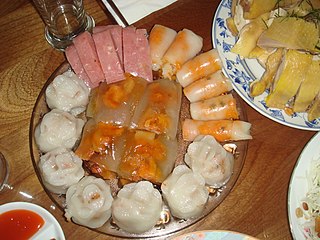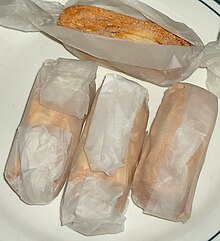
A cookie or biscuit is a baked snack or dessert that is typically small, flat, and sweet. It usually contains flour, sugar, egg, and some type of oil, fat, or butter. It may include other ingredients such as raisins, oats, chocolate chips, or nuts.

Dough is a thick, malleable, sometimes elastic paste made from grains or from leguminous or chestnut crops. Dough is typically made by mixing flour with a small amount of water or other liquid and sometimes includes yeast or other leavening agents, as well as ingredients such as fats or flavorings.

Kringle is a Northern European pastry, a variety of pretzel. Pretzels were introduced by Roman Catholic monks in the 13th century in Denmark, and from there they spread throughout Scandinavia and evolved into several kinds of sweet, salty or filled pastries, all in the shape of kringle.

Apas are very thin oblong-shaped biscuits sprinkled with sugar. They are a specialty of Quezon and the wider Southern Tagalog region; but they are also found in Cebu. They are also known as binuruhas in Sariaya. They are made with flour, milk, eggs, sugar, and butter. They are mild-flavored and are typically eaten with hot drinks.

Koulourakia or Koulouria, or kerkele in Pontic Greek, are a traditional Greek dessert, typically made around Easter to be eaten after Holy Saturday.
Ohaldres are Filipino puff pastries originating from the Visayas Islands. They are very similar to utap, and are sometimes considered a type of utap, but they have a denser texture and are sliced thicker. They are usually baked as tight spirals or double whorls and are around 1 to 3 in in diameter.

In Vietnamese, the term bánh translates loosely as "cake" or "bread", but refers to a wide variety of prepared foods that can easily be eaten by hands or chopsticks. With the addition of qualifying adjectives, bánh refers to a wide variety of sweet or savory, distinct cakes, buns, pastries, sandwiches, and other food items, which may be cooked by steaming, baking, frying, deep-frying, or boiling. Foods made from wheat flour or rice flour are generally called bánh, but the term may also refer to certain varieties of noodle and fish cake dishes, such as bánh canh and bánh hỏi.
A pastry heart is a regional dessert item found in the Western New York area, with Buffalo credited as the place it was first created.

A palmier, pig's ear, palm heart, or elephant ear is a French pastry in a palm leaf shape or a butterfly shape, sometimes called palm leaves, cœur de France, French hearts, shoe-soles, or glasses that were invented in the beginning of the 20th century.

Hodu-gwaja, commonly translated as walnut cookies, walnut cakes, and walnut pastries, is a type of cookie originated from Cheonan, South Korea. It is also known by the name hodo-gwaja in and outside Korea.

Pan dulce, literally meaning "sweet bread", is the general name for a variety of Mexican pastries. They are inexpensive treats and are consumed at breakfast, merienda, or dinner. The pastries originated in Mexico following the introduction of wheat during the Spanish conquest of the Americas and developed into many varieties thanks to French influences in the 19th century.

In Philippine cuisine, roscas or biscochos de roscas refer to a type of pastry cookies from the province of Leyte, mainly from the towns of Barugo and Carigara, made from lard, anise, flour, sugar, butter and eggs. These roscas are initially shaped as crescents or penannular rings. Each of the roscas is then cut in half before baking, resulting in two separate elbow-shaped cookies.

Kue lidah kucing is a small Indonesian biscuit shaped somewhat like a cat's tongue. They are sweet and crunchy. This cookie is a Dutch-influenced cookie due to the historical tie between Indonesia and the Netherlands. In the Netherlands, this cookie is known as kattentong, and ultimately derived from European cat tongue biscuit.

Balikucha, also spelled balicucha or balikutsa, is a type of traditional pulled sugar candy from the Philippines. It is made by boiling pure sugarcane juice or crystalline sugar until it caramelizes and becomes a syrup. It is then pulled and folded repeatedly against a nail until it turns a creamy white color. The resulting ropes of candy are then cut into sections and curled at the ends, resulting in a distinctive shape similar to palmier pastries. They are allowed to dry under the sun before being sold.













